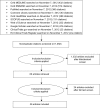Conversion of the Seattle Angina Questionnaire into EQ-5D utilities for ischemic heart disease: a systematic review and catalog of the literature
- PMID: 24876788
- PMCID: PMC4035107
- DOI: 10.2147/CEOR.S63187
Conversion of the Seattle Angina Questionnaire into EQ-5D utilities for ischemic heart disease: a systematic review and catalog of the literature
Abstract
Background: There is a paucity of preference-based (utility) measures of health-related quality of life for patients with ischemic heart disease (IHD); in contrast, the Seattle Angina Questionnaire (SAQ) is a widely used descriptive measure. Our objective was to perform a systematic review of the literature to identify IHD studies reporting SAQ scores in order to apply a mapping algorithm to convert these to preference-based scores for secondary use in economic evaluations.
Methods: Relevant articles were identified in MEDLINE (Ovid), EMBASE (Ovid), Cochrane Library (Wiley), HealthStar (Ovid), and PubMed from inception to 2012. We previously developed and validated a mapping algorithm that converts SAQ descriptive scores to European Quality of Life-5 Dimensions (EQ-5D) utility scores. In the current study, this mapping algorithm was used to estimate EQ-5D utility scores from SAQ scores.
Results: Thirty-six studies met the inclusion criteria. The studies were categorized into three groups, ie, general IHD (n=13), acute coronary syndromes (n=4), and revascularization (n=19). EQ-5D scores for patients with general IHD were in the range of 0.605-0.843 at baseline, and increased to 0.649-0.877 post follow-up. EQ-5D scores for studies of patients with recent acute coronary syndromes increased from 0.706-0.796 at baseline to 0.795-0.942 post follow-up. The revascularization studies had EQ-5D scores in the range of 0.616-0.790 at baseline, and increased to 0.653-0.928 after treatment; studies that focused only on coronary artery bypass grafting increased from 0.643-0.788 at baseline to 0.653-0.928 after grafting, and studies that focused only on percutaneous coronary intervention increased in score from 0.616-0.790 at baseline to 0.668-0.897 after treatment.
Conclusion: In this review, we provide a catalog of estimated health utility scores across a wide range of disease severity and following various interventions in patients with IHD. Our catalog of EQ-5D scores can be used in IHD-related economic evaluations.
Keywords: European Quality of Life-5 Dimensions; Seattle Angina Questionnaire; health-related quality of life; ischemic heart disease; mapping algorithm; utilities.
Similar articles
-
Mapping the Seattle Angina Questionnaire to EQ-5D-5L in patients with coronary heart disease.Health Qual Life Outcomes. 2023 Jul 3;21(1):64. doi: 10.1186/s12955-023-02151-9. Health Qual Life Outcomes. 2023. PMID: 37400827 Free PMC article.
-
Predicting EQ-5D utility scores from the Seattle Angina Questionnaire in coronary artery disease: a mapping algorithm using a Bayesian framework.Med Decis Making. 2011 May-Jun;31(3):481-93. doi: 10.1177/0272989X10386800. Epub 2010 Dec 2. Med Decis Making. 2011. PMID: 21127316
-
Mapping of the EQ-5D index from clinical outcome measures and demographic variables in patients with coronary heart disease.Health Qual Life Outcomes. 2010 Jun 4;8:54. doi: 10.1186/1477-7525-8-54. Health Qual Life Outcomes. 2010. PMID: 20525323 Free PMC article. Clinical Trial.
-
EQ-5D-Derived Health State Utility Values in Hematologic Malignancies: A Catalog of 796 Utilities Based on a Systematic Review.Value Health. 2020 Jul;23(7):953-968. doi: 10.1016/j.jval.2020.04.1825. Epub 2020 Jul 13. Value Health. 2020. PMID: 32762998
-
EQ-5D studies in cardiovascular diseases in eight Central and Eastern European countries: a systematic review of the literature.Kardiol Pol. 2018;76(5):860-870. doi: 10.5603/KP.a2018.0033. Epub 2018 Jan 19. Kardiol Pol. 2018. PMID: 29350378
Cited by
-
Mapping the Seattle Angina Questionnaire to EQ-5D-5L in patients with coronary heart disease.Health Qual Life Outcomes. 2023 Jul 3;21(1):64. doi: 10.1186/s12955-023-02151-9. Health Qual Life Outcomes. 2023. PMID: 37400827 Free PMC article.
-
Cost-Effectiveness of Fractional Flow Reserve-Guided Treatment for Acute Myocardial Infarction and Multivessel Disease: A Prespecified Analysis of the FRAME-AMI Randomized Clinical Trial.JAMA Netw Open. 2024 Jan 2;7(1):e2352427. doi: 10.1001/jamanetworkopen.2023.52427. JAMA Netw Open. 2024. PMID: 38270954 Free PMC article.
-
The estimated benefits of increasing cigarette prices through taxation on the burden of disease and economic burden of smoking in Nigeria: A modeling study.PLoS One. 2022 Mar 2;17(3):e0264757. doi: 10.1371/journal.pone.0264757. eCollection 2022. PLoS One. 2022. PMID: 35235606 Free PMC article.
-
Association between appropriateness of coronary revascularization and quality of life in patients with stable ischemic heart disease.BMC Cardiovasc Disord. 2014 Oct 4;14:137. doi: 10.1186/1471-2261-14-137. BMC Cardiovasc Disord. 2014. PMID: 25280534 Free PMC article.
References
-
- National Institute for Health and Clinical Excellence . Guide to the Methods of Technology Appraisal. London, UK: National Institute for Clinical Excellence; 2004. - PubMed
-
- Canadian Agency for Drugs and Technologies in Health . Guidelines for the Economic Evaluation of Health Technologies: Canada. 3rd ed. Ottawa, ON, Canada: Canadian Agency for Drugs and Technologies in Health; 2006.
-
- Longworth L, Buxton M, Sculpher M, Smith D. Estimating utility data from clinical indicators for patients with stable angina. Eur J Health Econ. 2005;6(4):347–353. - PubMed
-
- World Health Organization . Making Choices in Health: WHO Guide to Cost-Effectiveness Analysis. Geneva, Switzerland: World Health Organization; 2003.
-
- Drummond MF, Sculpher MJ, Torrance GW, O’Brien BJ, Stoddart GL. Methods for the Economic Evaluation of Health Care Programmes. 3rd ed. Oxford, UK: Oxford University Press; 2005.
LinkOut - more resources
Full Text Sources
Other Literature Sources
Miscellaneous


